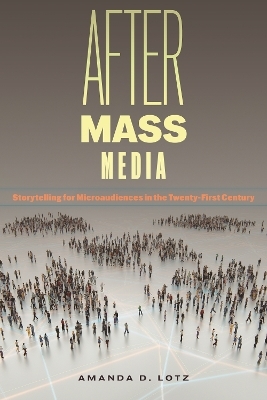
After Mass Media
Storytelling for Microaudiences in the Twenty-First Century
Seiten
2025
New York University Press (Verlag)
978-1-4798-3390-0 (ISBN)
New York University Press (Verlag)
978-1-4798-3390-0 (ISBN)
- Noch nicht erschienen (ca. April 2025)
- Versandkostenfrei innerhalb Deutschlands
- Auch auf Rechnung
- Verfügbarkeit in der Filiale vor Ort prüfen
- Artikel merken
Explores the cultural role of screen storytelling in society
With significant evolutions in digital technologies and media distribution in the past two decades, the business of storytelling through screens has shifted dramatically. In the past, blockbuster movies and TV shows like Friends aimed first for domestic mass audiences, although the biggest hits circulated globally. Now, transnational distribution plays a primary role and imagined audiences are global. At the same time, the once-mass audience has significantly fragmented to enable an expansion in the range of commercially viable stories, as evident in series as varied as Atlanta, Better Things, and dozens of others that are not widely known, but deeply loved by their microaudiences.
Delving into the changing landscape of commercial screen storytelling, After Mass Media explores how industrial shifts and technological advancements have remade the narrative landscape over the past two decades. Television and movies have long shaped society, whether by telling us about the worlds around us or far away. By examining the internationalization of screen businesses, the rise of streaming services with multi-territory reach, and the stories made for this environment, this book sheds light on the profound transformations in television and film production and circulation. With a keen focus on major changes in the types of screen stories being told, Amanda D. Lotz unravels the industrial roots that made these transformations possible, challenges some conventional distinctions of screen storytelling, and provides new conceptual tools to make sense of the abundance and range of screen stories on offer.
Through its comprehensive analysis, After Mass Media exposes how contemporary industrial dynamics, particularly the erosion of traditional distribution models based on geography and mass audience reach, have far-reaching implications for our understanding of national video cultures.
With significant evolutions in digital technologies and media distribution in the past two decades, the business of storytelling through screens has shifted dramatically. In the past, blockbuster movies and TV shows like Friends aimed first for domestic mass audiences, although the biggest hits circulated globally. Now, transnational distribution plays a primary role and imagined audiences are global. At the same time, the once-mass audience has significantly fragmented to enable an expansion in the range of commercially viable stories, as evident in series as varied as Atlanta, Better Things, and dozens of others that are not widely known, but deeply loved by their microaudiences.
Delving into the changing landscape of commercial screen storytelling, After Mass Media explores how industrial shifts and technological advancements have remade the narrative landscape over the past two decades. Television and movies have long shaped society, whether by telling us about the worlds around us or far away. By examining the internationalization of screen businesses, the rise of streaming services with multi-territory reach, and the stories made for this environment, this book sheds light on the profound transformations in television and film production and circulation. With a keen focus on major changes in the types of screen stories being told, Amanda D. Lotz unravels the industrial roots that made these transformations possible, challenges some conventional distinctions of screen storytelling, and provides new conceptual tools to make sense of the abundance and range of screen stories on offer.
Through its comprehensive analysis, After Mass Media exposes how contemporary industrial dynamics, particularly the erosion of traditional distribution models based on geography and mass audience reach, have far-reaching implications for our understanding of national video cultures.
Amanda D. Lotz is Professor in the Digital Media Research Center at Queensland University of Technology and the author and editor of several books, including Netflix and Streaming Video: The Business of Subscriber-funded Video on Demand, Media Disrupted: Surviving Pirates, Cannibals, and Streaming Wars and The Television Will Be Revolutionized, Second Edition.
| Erscheint lt. Verlag | 15.4.2025 |
|---|---|
| Reihe/Serie | Critical Cultural Communication |
| Zusatzinfo | 16 b/w images |
| Verlagsort | New York |
| Sprache | englisch |
| Maße | 152 x 229 mm |
| Themenwelt | Kunst / Musik / Theater ► Film / TV |
| Kunst / Musik / Theater ► Theater / Ballett | |
| Sozialwissenschaften ► Kommunikation / Medien ► Medienwissenschaft | |
| ISBN-10 | 1-4798-3390-8 / 1479833908 |
| ISBN-13 | 978-1-4798-3390-0 / 9781479833900 |
| Zustand | Neuware |
| Informationen gemäß Produktsicherheitsverordnung (GPSR) | |
| Haben Sie eine Frage zum Produkt? |
Mehr entdecken
aus dem Bereich
aus dem Bereich
Eine Einführung
Buch | Softcover (2022)
Springer VS (Verlag)
32,99 €
wie KI und virtuelle Welten von uns Besitz ergreifen – und die …
Buch | Hardcover (2023)
Heyne (Verlag)
22,00 €


